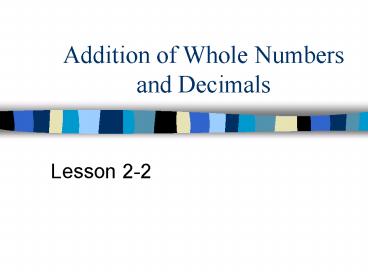Addition of Whole Numbers and Decimals - PowerPoint PPT Presentation
1 / 11
Title:
Addition of Whole Numbers and Decimals
Description:
To review place value concepts and the use of partial-sums and column addition. ... by one for each column as you move outward from the center in either direction. ... – PowerPoint PPT presentation
Number of Views:30
Avg rating:3.0/5.0
Title: Addition of Whole Numbers and Decimals
1
Addition of Whole Numbers and Decimals
- Lesson 2-2
2
Objectives
- To review place value concepts and the use of
partial-sums and column addition. - Write numbers in expanded notation
3
Mental Math
- Expanded form means taking numbers apart by their
place value. - For example 25 would be 20 5, taking the tens
and the ones apart. - Another example 0.351 would be
- 0.3 0.05 0.001
4
Mental Math Write the following numbers in
expanded form. Number your piece of paper 1 - 8
- 0.52 0.5 0.02
- 52 50 2
- 0.35 0.3 0.05
- 35 30 5
- 467 400 60 7
- 0.241 0.2 0.04 0.001
- 241 200 40 1
- 162 100 60 2
5
Math Message
- You need your SRB Student Reference Book.
- Turn to page 28 30.
- Use these pages to answer the Check Your
Understanding Problems on the bottom of page 30. - As you work, think about one true statement that
could be made about the base-ten system for
numbers.
6
Now that youve read the SRB
- Look at the place value chart on page 30 of your
SRB. - Look over the headings on the chart.
- Describe any patterns you see.
7
Here are some patterns you might have noticed
- The numbers decrease in size from left to right.
- The columns on the right side of the chart have a
decimal point and the left side does not. - The zeros 0s increase by one for each column as
you move outward from the center in either
direction.
8
Math Message Follow Up
- Each place has a value that is 10 times the value
of the place to its right. - For example, 1,000 is 10 times as much as 100
- 100 is 10 times as much as 10
- 10 is 10 times as much as 1
- 1 is 10 times as much as 0.1
- 0.1 is 10 times as much as 0.01
9
Check out how the numbers line up.
- 0.01 x 10 0.1
- 0.1 x 10 1.0
- 1.0 x 10 10.0
- 10 x 10 100.0
- 100 x 10 1,000.0
10
Whats the opposite of multiplication?
- Division of course.
- Each place has a value that is one-tenth the
value of the place to its LEFT. - For example
- 100 is 1/10 of 1,000
- 10 is 1/10 of 100
- 1 is 1/10 of 10
- 0.1 is 1/10 of 1
- 0.01 is 1/10 of 0.1
11
Division of numbers by 10s
- 0.01 x 10 0.1
- 0.1 x 10 1.0
- 1.0 x 10 10.0
- 10 x 10 100.0
- 100 is 1/10 1,000.0































